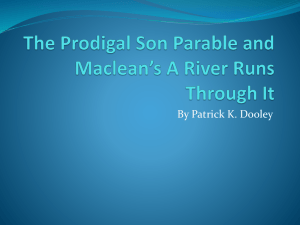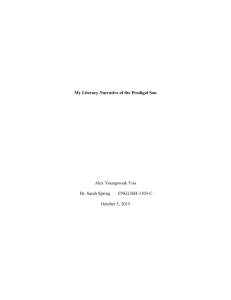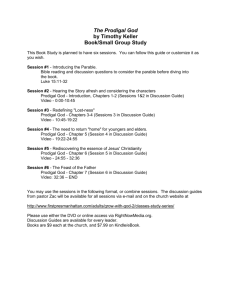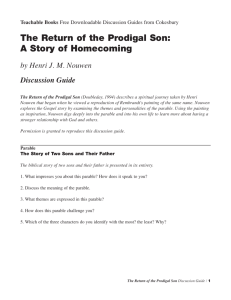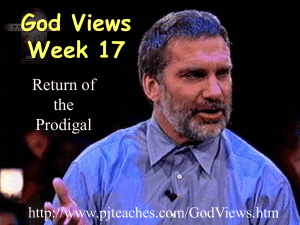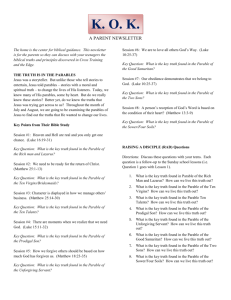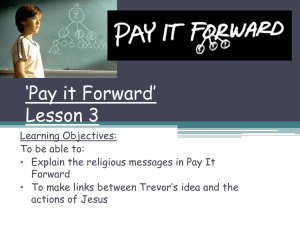Reflections on the Prodigal Son
advertisement
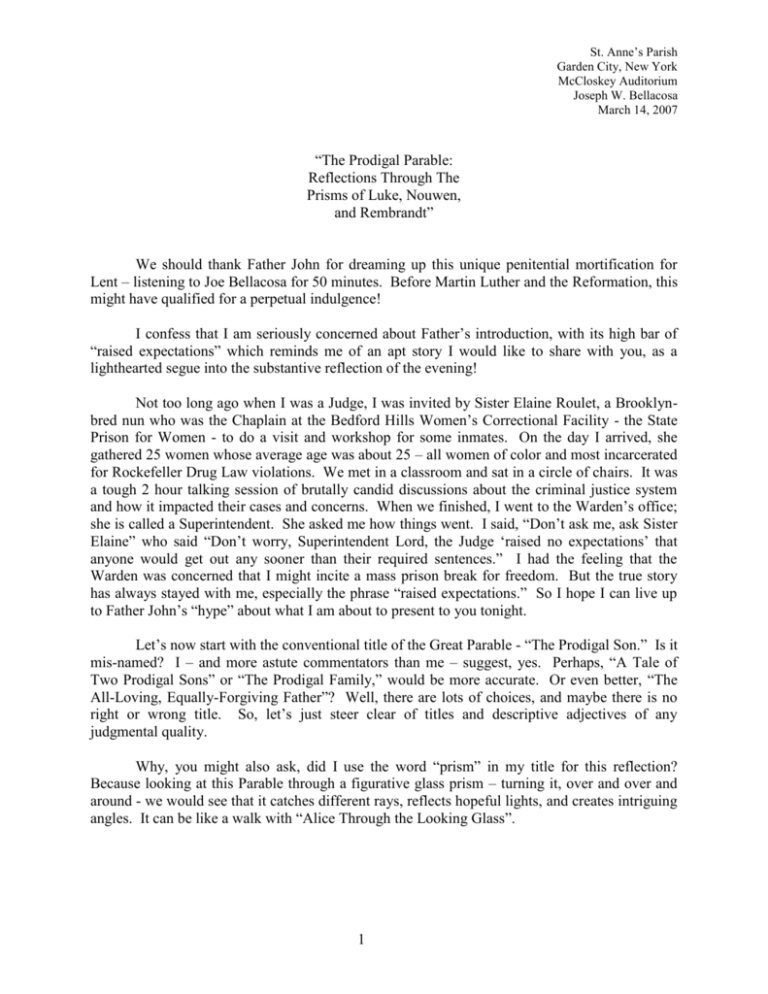
St. Anne’s Parish Garden City, New York McCloskey Auditorium Joseph W. Bellacosa March 14, 2007 “The Prodigal Parable: Reflections Through The Prisms of Luke, Nouwen, and Rembrandt” We should thank Father John for dreaming up this unique penitential mortification for Lent – listening to Joe Bellacosa for 50 minutes. Before Martin Luther and the Reformation, this might have qualified for a perpetual indulgence! I confess that I am seriously concerned about Father’s introduction, with its high bar of “raised expectations” which reminds me of an apt story I would like to share with you, as a lighthearted segue into the substantive reflection of the evening! Not too long ago when I was a Judge, I was invited by Sister Elaine Roulet, a Brooklynbred nun who was the Chaplain at the Bedford Hills Women’s Correctional Facility - the State Prison for Women - to do a visit and workshop for some inmates. On the day I arrived, she gathered 25 women whose average age was about 25 – all women of color and most incarcerated for Rockefeller Drug Law violations. We met in a classroom and sat in a circle of chairs. It was a tough 2 hour talking session of brutally candid discussions about the criminal justice system and how it impacted their cases and concerns. When we finished, I went to the Warden’s office; she is called a Superintendent. She asked me how things went. I said, “Don’t ask me, ask Sister Elaine” who said “Don’t worry, Superintendent Lord, the Judge ‘raised no expectations’ that anyone would get out any sooner than their required sentences.” I had the feeling that the Warden was concerned that I might incite a mass prison break for freedom. But the true story has always stayed with me, especially the phrase “raised expectations.” So I hope I can live up to Father John’s “hype” about what I am about to present to you tonight. Let’s now start with the conventional title of the Great Parable - “The Prodigal Son.” Is it mis-named? I – and more astute commentators than me – suggest, yes. Perhaps, “A Tale of Two Prodigal Sons” or “The Prodigal Family,” would be more accurate. Or even better, “The All-Loving, Equally-Forgiving Father”? Well, there are lots of choices, and maybe there is no right or wrong title. So, let’s just steer clear of titles and descriptive adjectives of any judgmental quality. Why, you might also ask, did I use the word “prism” in my title for this reflection? Because looking at this Parable through a figurative glass prism – turning it, over and over and around - we would see that it catches different rays, reflects hopeful lights, and creates intriguing angles. It can be like a walk with “Alice Through the Looking Glass”. 1 St. Anne’s Parish Garden City, New York McCloskey Auditorium Joseph W. Bellacosa March 14, 2007 For example, one may see what the Apostle Luke intended his hearers to understand (the only one of the four Gospel-writers, by the way, who recounts the Prodigal Parable); or others may see what Luke wanted readers across the centuries to discern through divinely inspired revisitations, or revelations; or still others may be gifted to see the dynamic, living, breathing, writhing, – and yes sometimes baffling – nature of relationships at work, in tension, in turmoil, and in real time, real life encounters; or everyone may be moved finally to action – a radical change in one’s lives - by the Parable story’s manifestations of restless, tough and seemingly always unfinished love. Now is that enough to chew on, or what? I suppose I could stop right here, as Mary might recommend, but I know Father John wants me to say a bit more-because he has “raised expectations.” This time I’ll listen to him over Mary, though usually she gets priority, earned through almost 47 years of happily married penance with me. Here’s another angle that I, your fellow-lay person of this wonderful parish and community sees through his prism. Whatever the Scripture Writer Luke’s intention, or the Spiritual Mystic Nouwen’s musings, or the Artistic Rembrandt’s rendering, I share with you the belief that the Bible is divinely inspired. To me, the driving force of the Holy Spirit’s inspiration for this Parable is “Pilgrimage,” walking or wandering through life and its relationships, with an identified ultimate destination. Everyone of us has to walk this walk, and take a personal pilgrimage. The Prodigal Parable, thus, offers guidance along the path, and emphasizes how to deal with the people we encounter in all kinds of relationships – not just our immediate nuclear family. You see, this Parable represents a dynamic “process,” not a static dry dock. It is not a snapshot story, freeze-framed in olden times. It has multiple and evolving meanings, and the cast keeps changing – at least as applied to our lives in contemporary settings. What do I mean by that? Well, let’s see how anyone can get the most and best out of it. First, always read and reflect on the Scripture words themselves. They are only a small part of Luke’s Gospel, Chapter 15 - just 21 sentences or verses long. That is barely a short story, but every word is meaningful. I hesitate to pick out a favorite or most important one. But six key ones that I extract, and that you can take home are: (1) Relationships, (2) Family, (3) Forgiveness, (4) Generosity, (5) Pilgrimage and (6) Prodigal – in no order of priority, but generating a lot of prismatic angles. The next step is to read, or at least refer, to Father Henri Nouwen’s magnificent spiritual reflection “The Story of Homecoming – The Return of the Prodigal.” I think that book is also 2 St. Anne’s Parish Garden City, New York McCloskey Auditorium Joseph W. Bellacosa March 14, 2007 mis-titled or at least incomplete. In Father Nouwen’s opinion, the Prodigal Parable is said to sum up “the whole of the Good News Gospel message.” His book about this one painting by Rembrandt is 150 pages long, and it is wonderful. But I do not agree that it encapsulates the whole Gospel message. To me, every good Christian would need more - at least St. Matthew’s Gospel, Chapter 25, with its familiar particularized code of conduct and warnings, as well, instructing us as follows: feed the hungry quench the thirsty clothe the naked visit the imprisoned nurture the sick welcome the alien console the dying and their families Why? Because when you do those things to the least among us, we are admonished, you do them to God Almighty! That adds a lot more particularized guidance to the Prodigal Parable, in my opinion. As great as the Parable is, there must be more, and all of us need other specific instructions as part of the Gospel Good News message. In fact, I know people who don’t particularly like, or don’t wholeheartedly agree with, some aspects of the great Parable. For example, they think the Father Figure is too forgiving of the young son’s prodigality and disrespect. He is viewed as the Ultimate Enabler, so to speak. Critics also think, the elder son gets a raw deal from the Father Figure, after being so darned good and staying home to take care of things all those years. He seems unfairly eclipsed or displaced by the sudden change of events and relationships. Anyway, there is room for discussion and differences of opinion. As a third suggested step, look upon and ponder Rembrandt’s extraordinary masterpiece entitled “The Return of the Prodigal.” It was painted, circa 1669, in the final year of the artist’s prolific life. The original is 10 by 8 feet in size. It is the entire focus of Nouwen’s reflections in his unique book. The center of the painting is empty space – a gaping distance among the familial relationships. This is contrary to artistic painting techniques which usually focus the viewers’ eyes to the center of any painting. The center here, however, represents the emptiness and chasm between the young contrite son in the embrace of the father, sharply removed from the angry elder son standing apart on the opposite side. Look at the print, (or if you are lucky like me and Mary were in June 2005, pause before the original masterpiece hanging in the Hermitage Museum in St. Petersburg, Russia). Now that was a pilgrimage, and a privilege! A viewer’s eyes, upon encountering the great painting, are forced to shift from left to right and back again, to the father and son in loving embrace, and then to the lonely, stiff-backed, alienated elder son. It is powerful imagery in the body language, in the faces, the postures, and especially 3 St. Anne’s Parish Garden City, New York McCloskey Auditorium Joseph W. Bellacosa March 14, 2007 the hands. It is also beyond the literal Scripture, because Rembrandt, using artistic license, brings the elder son right into the main scene – the return and forgiving, loving embrace of the father and younger son – when in the Scripture the elder son doesn’t show up until later – after the party is in full swing. I would like you to know that I first read Father Nouwen’s book over a dozen years ago, and my fascination with the subject continues to grow. In fact, my preparation for this evening brought me to the Garden City Public Library and to a startling fresh insight. A large excellent biography, entitled “Rembrandt’s Eyes” by regular New Yorker Magazine contributor, Simon Schama, reminded me an early Prodigal rendition by Rembrandt, painted 35 years earlier than the one we know so well. In 1635, the young artist painted himself as a bon vivant, in something entitled, “The Prodigal with a Whore.” He is the center of a “wine, woman and song” painting, with one hand around the woman, the other hand grasping a goblet, and a leering, lecherous grin on his full face looking front and center. It is a shocking and vivacious representation of selfconfessional, personal prodigality. To see the earlier original painting, by the way, would require a pilgrimage to the Museum Gallery in Dresden, Germany. The younger son’s journey back, as the broken, kneeling figure with his back to the painting, is overpowering because Rembrandt’s life and artistic renderings in this genre represent the fullness of the Great Parable, spanning 35 years of the artist’s own dissolute life. If you have to stay local in your museum – gallery hopping, the J. Pierpont Morgan Library and Museum on Madison and 36th in New York City has a very different black and white etching of the “Return of the Prodigal Son” – from yet another angle, a side view. It is a third Rembrandt rendition, reflecting his identification and fascination with the Parable throughout his adult life. By the way, Rembrandt’s final Prodigal painting, in my opinion, is also mis-titled. Why? Because surely it is not just about “the return of the one son.” The very genius that inspired Rembrandt to place the elder son in the key scene shows that the painting is, at least, about two prodigal children, representing the mass and variety of humanity. In what I have dubbed a three–step process, experienced personally by me over many days, weeks, months and years, each one of us could enter into further study of the Scripture, the Nouwen Book and the Rembrandt Painting – and other musical and ballet versions. We might then come to see ourselves by introspection, or by examination of conscience, as the younger child or the elder one, as a brother or sister too, or the constantly “coming out” Father (Abba), a kind of “Uber Parent.” Be assured, however, it is also about daughters and mothers, as I will shortly explain. The Prodigal Parable, therefore teaches us not about role playing, but about role living. Moreover, the process of identification is not a sudden vision or inspiration. It takes time to work it out, and live it out. And, it most certainly is about change because, as the Greek philosophers discovered and propounded, life is change and is in a constant state of flux. Those 3 (three) main characters, in the Prodigal Parable, with a few barely discernible background bystanders represent the ensemble cast of who we are, and what we are doing at 4 St. Anne’s Parish Garden City, New York McCloskey Auditorium Joseph W. Bellacosa March 14, 2007 different stages of our lives. There is momentum, instruction and inspiration from the Scriptural message. The key and critical feature is the inter-actional relationships we all have with one another on our journey of faith. In a sense, it is the Personal Pilgrimage, that is searching and yearning for a metaphorical, mystical Home. Not so surprisingly, Bishop Murphy’s Pastoral Lenten message centers on the Prodigal Parable, in its suggested reflection on reconciliation and forgiveness. He even quotes a fabulous sentence from the late, Great Pope John Paul II: “The Prodigal Son is every human being, bewitched by the temptation to separate from the Father in order to lead an independent existence.” The point is this: the fantasy of independence is fatuous and ill fated. It is a fool’s journey – a frolic and detour! Besides, the Ultimate Parent is always yearning, looking out and taking the initiative, the first step in coming out to welcome the return of every one of us. That is so magnificent because, in addition, no offense is taken for our weak departures, even when we are foolishly resistant and surly, like the elder son’s repugnant responses to the father’s entreaties, or like the younger son’s premature demand for his presumptuous share of an inheritance from a father who is still very much alive. Just turn my figurative prism over and over in your mind’s eye for a moment, and think about who you are at a given moment in your daily life, or at some critical crossroads. Then consider what you are called to do in that particular moment and circumstance for yourself, in relation to others, and especially in relation to your Loving God. The Prodigal story simply reminds us that this is a lifetime of work, of dynamic unpredictable and connected events, and especially of prayer, too, to find the right path to Home, grasping at all the help and aid we can find along the way. This Parable might, in the end, be viewed, very simply, as a call to awareness of one self and one another, and especially of People all around us, and ultimately of God’s hopes for us. As a law trained person and Judge, I might rephrase the call to awareness as a “Summons” or “Subpoena” to account and answer for one’s actions. For God, it is a kind of theological writ of habeas corpus – “you have the body, now bring it to Me.” Borrowing from techniques taught in Schools of Journalism, the Parable suggests a way to work through this process. I ask myself, and would ask each of you to ask yourselves: Who Am I Really? Who Are These Others All Around Us? What Am I Called to Do In Life and Various Relationships? Where Am I On My Journey At This Point? When Is This Happening? My Favorite Trio of Questions and Reflections, added for this Exercise: Why Am I in this Pickle of Relationships, with their Tensions, and Surprise Twists and Turns? How did I get here? And, Where Do I Go From Here? The last question is perhaps the most important of all. If you don’t believe me, then take your lessons from Father Nouwen, Rembrandt, and St. Luke. 5 St. Anne’s Parish Garden City, New York McCloskey Auditorium Joseph W. Bellacosa March 14, 2007 OK, the context for our conversation tonight seems to be growing exponentially. Frankly, this material constitutes merely a springboard for my own reflections, encapsulated in this Lenten exercise. Take what you want of it because there is always even richer and more nuanced unfolding contexts, provided through the eyes and thoughts of wiser folks than me, including each of you. As one example, when I stopped by the Rectory a week or so ago to iron out some logistical details, Father John loaned me a personal book called “Rembrandt’s Jesus” by Tony Maan. It is much slimmer than Schama’s Rembrandt biography, but striking in its pictorial reproductions and reflections, too. It is another magnificent resource in its own collection of a large body of Rembrandt’s religious work, including a large section on (no surprise) the Prodigal. He, too, gives Top Billing, the marquee, main character role to the loving Parent, not to the two errant children, though they play big supporting roles. Let me please now inject a somewhat collateral comment. Why am I the one leading this local lecture–type pilgrimage about the Great Parable tonight? Well, let me tell you how it came about. Father John, with his appropriately challenging priestly ministry and pastoral technique, and his personally captivating style – asked me to offer this Lenten “exercise.” I accepted the invitation and challenge, not as some negative Lenten “sacrifice” or “burden,” but rather as a chance to do something positive. Besides, this “exercise” for me is really a delight and an opportunity to share a subject I have come to love. In a sense, it is a giving back of some of this special treasure that has come my way. We are told that we should not hide or horde our God– given charisms, right? On reflection, I also realized it might be worthwhile and possibly even fun to share some thoughts with you, because you freely chose to attend and listen to what turns out to be my 15 year wrestling match with the Prodigal Scripture story, enhanced by its several major offshoots, like Nouwen and Rembrandt. Again, this was quintessential Father John – seeing the need to poke and prod everyone, himself included, into an action mode of listening and sharing, of service to others, of improving and healing relationships. In this parish community of faith, no lights or lamps under bushels are tolerated, without some appropriate challenge to the comfortable status quo. And to those who don’t understand or accept that, I can only say respectfully, “Wake up!” Think about it this way - isn’t that yet another provocative elbow of discernment through the Prodigal Parable Prism? Relationships! Even all of ours, as a parish and community! Maybe, that is the most important lesson and word of all to take away from this evening’s reflection. This Parable points us, without distractions, simply and directly to God and one another. The Parable, like the joyful, embracing, forgiving, parental figure in it, however, does not force the issue or the ensuing action. Dignity, respect and power are offered on the one side, with the free-will choice to accept love and forgiveness on the other. We are invited to reciprocate - by choice, not by coercion. And relationships segue right into the Great Commandments, (don’t they?) the summary of the whole law – Love God and Love All Neighbors As Oneself! 6 St. Anne’s Parish Garden City, New York McCloskey Auditorium Joseph W. Bellacosa March 14, 2007 Here is yet another way to think about our subject. This Parable is a short three-act play, with three main characters. It presents a universal “Everyman” story. And, it is a story of nuanced surprises, filled with mystery. The surprise ending, for example, is that the story does not end. We are left hanging and wondering how does this end - especially for the elder son in his relationships with his father and younger brother. Does the elder son finally accept the father’s second coming out to explicitly invite him also to come in to join in the family festivities? How does that open-ended, persevering plea bear on our individual restless, ongoing journeys of faith, family and relationships - for they surely also do not end? Notice, too, so very, very importantly, how the father never responds in kind to his resentful, angry, spiteful stay–at– home son – spewing sarcasm at his own father, with the remark – “that son of yours!” The Father never lets that son push his buttons. Instead, he responds gently and joyfully, “your brother is alive”! And he is undeterred–resisting any reciprocal reactions of thin-skinned, hurt or harmful feelings. How does this angle of reflection bring us back to the conversations between Father John and me? That is where you all come in. You see, he and I have talked countless times and many hours about this Parable because we are both intensely interested in it, and we think we derive personally beneficial insights and instruction from our contemplation and conversations about it. But do we have some exclusive self–possessory interest in our exchanges? No way! How may this observation help further to set the table of our conversation here tonight with all of you? Frankly, I was not entirely sure and was worried about being perceived as presumptuous or a haughty, know-it-all. I finally concluded that handwringing over logistical questions was silly. No need to worry about false modesty. Instead just agree to do it, and be an instrument for whatever good may flow from it to whomever it reaches or touches. Father John and I agreed that something profound continues to stir from this Parable, for we feel it. How else to explain why we keep coming back to it? That is how this exercise emerged! One of Father John’s charisms, you see, is to prompt me (and the parish family) to share my and your charisms, as something potentially valuable. Mary, of course, is also an integral part of my and her own Pilgrimage, as individuals and as a happy couple of almost 47 years of marriage. She is a full partner, part and parcel of our story and our shared charisms. Let me now please “step back” and try to summarize, synthesize or extract some Bellacosa Lessons from my personal pilgrimage with the Great Prodigal Parable. They are not exclusive, and there may be better ones you have, or may come upon, or may yet come up with. The following, however are five (5) lessons that I find most helpful, so far along this stage of my journey, and I add some commentary, as well, to each: First ─ Read the Scripture words themselves, again and again. They provide a constant epiphany of insights and new applications, and, after all, they are the true inspired First Source. Be forewarned, however, the story is not as tranquil as it first appears and does not guarantee peace of mind. It is filled with challenges, anxiety, contradiction and some questionable actions and motives. Yet, hope permeates its every fiber. 7 St. Anne’s Parish Garden City, New York McCloskey Auditorium Joseph W. Bellacosa March 14, 2007 Second ─ Ponder the action – not in an action-movie sense, with wild kinds of special-effects, like car chases and crashes and explosions. I think even the younger generation can appreciate action scenes like the partying, or even the “Gimmee my inheritance now, or at least gimmee the car tonight, Dad or Mom.” Speaking of movies take a look, if you can, at Franco Zeffirelli’s 1977 movie, “Jesus of Nazareth.” I got the DVD from the Garden City Public Library on the recommendation of a Vincentian priest friend, Father Pat Griffin, C.M., from St. John’s University Board of Trustees. He teaches Scripture at the Seminary in Huntington. The movie depicts a fascinating prodigal analogy in a scene, with full Hollywood movie-making license. Conceivably, it portrays the original parable story, showing Jesus recruiting the pariah, tax collector, Matthew, as an Apostle. Matthew, in turn, invites the Good Lord to dinner at his home, to the consternation of Peter. The Lord enters the outcast’s home, associates with the revelers and, in the long movie scene, recites the whole Prodigal Parable to the quieted assembled outcasts, while Peter watches and listens, in anger outside the door of the house. The scene ends when the Lord finishes the Prodigal story. Suddenly a silent and converted Peter is seen entering and embracing Matthew. It is a glorious cinematic interpretation. Think about the parallels and differences. Also recognize, however, that this Prodigal Tale is not some Mary Poppins Feel Good Story, as it is sometimes depicted just because the younger son came home, asked for and was given forgiveness, and they had a party. Neither, on the other hand, is it Arthur Miller’s dismal depressing Death of a Salesman. It presents, instead, a serious puzzlement about the unfinished story of the deeply disappointed son who stayed home, among other tantalizing aspects. There is not an ounce of sentimental, romanticized “Joy to the World” or “They All Lived Happily Ever After” in this poignant yet wrenching saga. Third ─ Let me please add a word about a special personal spin off. When Mary and I were fortunate to go on our Russian pilgrimage, – I talked a lot (no surprise in view of tonight) to 30 fellow tourists, about Henri Nouwen’s insights on all of this, and of my anticipation for seeing the original masterpiece. For example, I pointed out that Nouwen noticed that Rembrandt had painted the embrace of the two figures, with beautiful grasping hands of the Father as a unique focal point. Nouwen pointed out that Rembrandt painted one male and one female hand, clutching the son to his breast. Father Nouwen thus intuited a bi-gendered and interpreted an un-gendered Father in the painting, presented as the Universal Parent, and Our Godhead figure. This representation removes, or at least equalizes, the gender references among the Parable participants, and makes its lessons and wisdom applicable to all God’s children not as a matter of political correctness, but rather as a transcendent representation 8 St. Anne’s Parish Garden City, New York McCloskey Auditorium Joseph W. Bellacosa March 14, 2007 of the true Godhead. I recounted this aspect for the captive audience of my fellow travelers, as an extraordinary insight and some very powerful mystical stuff from Father Nouwen. Our tour group in Russia seemed to appreciate the specialness of that aspect – and then upon seeing it for themselves in the famous original painting when we got to it on the tour of the Hermitage, they were as moved as I was by that and by the whole experience. You see, when we arrived for a specially arranged private entry at 8 AM on the day of our Hermitage visit, I had personally peeled off from the group, went directly on ahead to the Rembrandt Gallery at the vast museum and spent over an hour alone before the painting. I had in advance researched the precise location and room number. My friends asked later whether all my expectations were met. Remember my opening story about “raised expectations”? I told them that my excited anticipation and expectations were actually vastly exceeded. Relentlessly, throughout the tour in 2005, I subjected them to my description of the Nouwen book at dinners and on bus and train rides together through the Baltic and Russian countrysides, until we finally arrived in St. Petersberg, as the final stop of a fabulous two week tour. What a build up! Several of our fellowtravelers had even borrowed the personal copy of my Nouwen book I carried on the trip, for their overnight readings in hotel rooms to enhance their own experience and preparation for when they finally caught up to me for their viewing of the great masterpiece. This was truly infectious and my enthusiasm seemed to serve as a special spark of sharing - just as I hope it is tonight for you. Fourth ─ I would now ask you to ponder this core ingredient, as a central lesson: Unconditional and always available forgiveness, represented by the Father “Coming Out” twice to both sons separately in love, equality, understanding and compassion. This is the transcendent theme and ideal of the Parable. It is an action trope for living one’s life better. And it is magnificent, in its hopeful encouragement despite the realistic trials, travails, and tribulations of life’s journeys for each of us. Consider this flipside nuance, however: The paradox of the dynamic and ongoing nature of life, versus the sense of a completed embrace of love and act of forgiveness. Fifth & Last ─ I confess that struggling with the Justice angle of the Parable is particularly troublesome and tough for me – and not wholly resolved. Was the Father, “fair” to the elder son? Was he “just” to the young son and brother? Consider this Scriptural parallel. Was the Vineyard Owner – in, as I see it, a related Parable found in Matthew’s Gospel – “fair” to the all-day laborers when he gave the afternoon tag-alongs the same wage, as that given to those who worked all day? Was this equal justice? 9 St. Anne’s Parish Garden City, New York McCloskey Auditorium Joseph W. Bellacosa March 14, 2007 The Maan book, entitled “Rembrandt’s Jesus”, devotes a significant section to the connectedness of this Matthew Gospel Parable of the Vineyard Workers to Luke’s Prodigal Parable (although textually the Prodigal is part of Luke’s triple “lost” series of stories – sheep, coin and son). In both primary parables, the common value or virtue, if you will, is GENEROSITY. The lesson, I extract and propound, is that generosity trumps a tit-for-tat approach to life. It displaces the eye-for-an-eye, lex talionis Old Testament, approach to justice. The new and good news is, transcendentally, all about Generosity of Spirit and Action. The Parable of the Vineyard Workers is one of the most challenging parables for me as a lawyer and former judge. Both parables, you see, partake of a humanly unbalanced tension, and in that respect I can see why many people are unsettled by them. Fairness and equal justice – whatever those values humanly connote and logically mean – evidently do not trump generosity of spirit and unqualified love – in God’s plan. It is the other way around, for Him, and they are not inconsistent. That is one explanation that I now get out of the Prodigal and Vineyard Parables, thanks to Father Henri Nouwen’s efforts and revelations to us. But that angle from the prism is tough to accept and to see; indeed, very hard to understand in our human terms and as part of modern American culture. Father Nouwen, thankfully articulates, with astonishing simplicity – that we struggle with, judging and weighing the seemingly unjust and unfair imbalances of these Parables, through our limited and fallible human eyes, instead of through the penetrating Divine perspective of a thoroughly, generous God. The Lord keeps telling us that even, despite our human limitations, we should keep trying to follow His lead and example and strive for the true ideal of those virtues, as He has shown us. Are there other lessons and insights? Absolutely! We are dealing here with an inexhaustible set of sources and treasures. So, why do I stop at five? Because I have to wind things up, and I want to also leave you with some sample questions to take away from this evening – a kind of personal homework, but no examination – at least not from me! Besides, this is a restless, ongoing story with evolving applications to each of our journeys in life. Since the story itself has no end or resolution, and the pilgrimage has no final earthly destination, as such, every one of us has new lessons regularly to activate, experience and share. Ponder then, and pray over these (seven) 7 arbitrarily chosen brainteasers; they will test your spirit: 1. 2. 3. 4. With whom do most people identify in the story? Does anyone want to be the sad, stay-at-home, obviously alienated and angry son? Who is the real Central Character of the Parable, despite the historical title and adaptations? Who is the party really for – surely not the poor fatted calf? 10 St. Anne’s Parish Garden City, New York McCloskey Auditorium Joseph W. Bellacosa March 14, 2007 5. 6. 7. Do not our culture and intuition suggest that any parent’s more likely human response would be criticism, condemnation and judgmentalism with respect to the questionable conduct of both sons? Instead, is the fundamental lesson counter-cultural and counter-intuitive – that a true Parent’s forgiveness and invitations to family healing and reconciliation of relationships should ideally prevail over alienation and jealousy? Think, too, whether the original audience for the Parable was Jews and Gentiles, represented respectively, one might say, as the Elder and Younger Sons? Is there a parallel today between so-called conservative and liberal Catholics? Who are the stay-athome caretakers of “The Truth” vs. the Wanderer-Squanderers of “the Truth?” I respectfully suggest to you that Jesus would not like or favor the categorizations, labels, and respective self-righteous condemnations and finger pointing. He surely wants them all equally at home, and at mutual amity and joy, just like when he invited the despised tax collector, Matthew to follow Him as a brother–Apostle to Peter, and made him one of His own most intimate family of followers. Fellow parishioners of dear St. Anne’s and other guests, I apologize for the length and breadth of this excursion, containing so many words and ideas. But, as you can tell, the simple Luke Parable of the Prodigal, with its magnificent representation by Rembrandt, evokes complex insights and lessons, to say nothing more of what Father Nouwen saw and gave us in his extraordinary book. This evening’s production of the Joe Bellacosa reflections through the Prism of the Prodigal Parable was, of course, brought to you by the good offices of Father John. I want to conclude by thanking Father John for inviting me to do this, and all of you for coming, and letting me anticipate, by sheer coincidence, this coming Sunday’s Gospel Good News of the Prodigal Parable, and even last Saturday’s weekly Gospel reading of it, too. Let me emphasize that I surely do not view my exercise tonight as a substitute homily – as that is well beyond my lay competencies. You have instead very kindly allowed me, a fellow Catholic layperson, to explore and expose my enthusiasms and reflections with you on this part of my personal journey of Faith, enlightened in a special way by the Prodigal Parable and its manifold epiphanies. It continues to help me to become even more aware of how grateful I need to be for the gift of my Faith, and its constantly evolving discernments which give each of us a Scriptural GPS tracking mechanism for the mysterious and challenging pilgrimage of life. One might say that it is a personal navigation system – sending guidance from a place higher than a satellite. Be open to receiving the message. Tonight has been, another WOW moment in my life, including the preparation, reading, and time devoted to presenting my talk with you – and the actual experience of doing it. The additional wonder of this opportunity is that, though I am thankfully done here tonight, (I am sure you are even more thankful), the Prodigal Parable Prism shows us that the pilgrimage continues to unfold. 11 St. Anne’s Parish Garden City, New York McCloskey Auditorium Joseph W. Bellacosa March 14, 2007 So, where do I, and we go from here? And who is there to encounter me, on the road ahead? For the short term answer, I turn things back to our inspiring priest and pastor, Father John, with my respect and gratitude for this gifted evening. (Questions and Answers) *** 12
